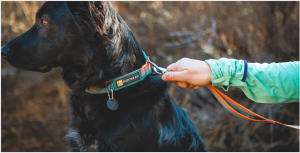If you’ve ever gone shopping for a dog collar, you already know it’s not as simple as picking the first cute one on the rack. I’ve been there—standing in the aisle, surrounded by hundreds of sizes, colors, and materials, wondering if I’m overthinking something as small as a neck strap. But trust me, it matters.
Through my years as both a pet parent and digital marketer writing about pet products, I’ve learned that a dog collar isn’t just an accessory—it’s a tool for safety, training, and even personality. In this guide, I’ll share what I’ve learned about choosing the right collar, the types worth considering, and how to make sure it actually fits your furry friend comfortably.
Let’s start by laying out what you’ll find in this article.

What You’ll Learn in This Guide
- Why a collar is more than just an accessory
- The key features I check before buying
- A breakdown of popular collar types
- The pros and cons of each design
- Safety and sizing tips every owner should know
- My personal recommendations based on experience
- Common mistakes to avoid when picking one
- How to maintain your collar so it lasts longer
Why the Right Collar Matters
I used to think collars were mainly about fashion. Then one day, my dog slipped out of a cheap, loose-fitting one during a walk—and let’s just say I sprinted faster than I ever have before. That moment taught me that comfort and security always come before color and pattern.
A proper collar does three main things:
- Keeps your dog safe and under control – especially in public areas.
- Holds identification tags, which can be life-saving if your pup gets lost.
- Assists with training—certain types are designed to discourage pulling or jumping.
So yes, your dog might look adorable in a polka-dotted collar, but if it doesn’t fit properly or rubs their skin, it’s not doing its job.
What I Look for When Choosing a Collar
After years of trying different materials, styles, and brands, I’ve developed a simple checklist.
- Fit: A collar should be snug but not tight. I always use the “two-finger rule”—if I can slip two fingers between the collar and my dog’s neck, it’s the right fit.
- Material: I prefer soft nylon or leather for comfort and durability. For water-loving dogs, waterproof collars are a game changer.
- Hardware quality: Buckles should feel sturdy, not flimsy. I avoid plastic clips for large or active dogs.
- Weight: Lighter collars are better for small breeds. Heavy ones can strain their neck.
- Design and visibility: Reflective stitching helps during nighttime walks, and bright colors make your dog easier to spot.
If a collar checks all those boxes, it’s already ahead of 80% of the products out there.
Types of Collars (and When to Use Them)

I’ve experimented with nearly every type of collar you can find. Here’s how they stack up:
1. Flat Collars
The most common type—simple, classic, and ideal for everyday use. I like flat collars for dogs that don’t pull on the leash. They’re comfortable, easy to adjust, and come in countless styles.
Pros: Affordable, comfortable, customizable.
Cons: Not ideal for strong pullers.
2. Martingale Collars
These are my go-to for dogs that slip out of regular collars. They tighten slightly when pulled but not enough to choke. Perfect for breeds with narrow heads like Greyhounds or for dogs who like to play escape artist.
Pros: Prevents slipping, gentle correction.
Cons: Should not be left on unsupervised.
3. Harness Collars (Hybrid Designs)
Technically not just collars—but they deserve a mention. I use a harness-collar combo for my more active dogs. It distributes pressure across the chest rather than the neck, which is safer for smaller breeds.
Pros: Reduces strain, great for walking control.
Cons: Takes longer to put on and remove.
4. Leather Collars
Durable, stylish, and surprisingly long-lasting. My first leather collar lasted nearly five years. They age beautifully but require some maintenance to prevent cracking.
Pros: Long-lasting, softens with use, elegant look.
Cons: Pricier and not ideal for frequent swimmers.
5. Waterproof or Biothane Collars
I call these the “adventure collars.” If your dog loves mud, swimming, or rain, this is your friend. They don’t absorb water, smell, or stain.
Pros: Low maintenance, waterproof, odor-free.
Cons: Limited style variety compared to leather.
6. Training Collars (for Experienced Use)
Used for specific training situations—not daily wear. I always emphasize gentle correction over force. If you’re using one, get professional guidance first.
Pros: Effective for specific behavior training.
Cons: Misuse can cause harm or fear.
How I Size a Collar Correctly
I can’t stress this enough: sizing is everything. A collar that’s too tight can cause irritation, while one that’s too loose risks slipping off.
Here’s my sizing rule of thumb:
- Small dogs: ⅜” to ¾” wide collars.
- Medium dogs: ¾” to 1″ wide collars.
- Large dogs: 1″ to 1½” wide collars.
When measuring your dog’s neck, use a soft tape measure. Add two inches for breathing room. Simple, yet often overlooked.
Materials: Which One Should You Choose?
There’s no “one-size-fits-all.” The right material depends on your dog’s activity level and lifestyle.
| Material | Best For | Notes |
| Nylon | Everyday wear | Lightweight and affordable |
| Leather | Style & durability | Requires conditioning |
| Biothane | Outdoor activities | Waterproof and odor-resistant |
| Chain | Training only | Use under supervision |
| Eco-fabric | Sensitive skin | Soft and sustainable |
Personally, I rotate between nylon and biothane depending on the season.
A Word on Smart Collars
Tech has reached our pets, and I’m not complaining. Smart collars now track location, activity, and even sleep patterns. I’ve tested a few, and while not essential for everyone, they’re incredibly helpful if you live in busy areas or travel often.
Tip: Always check battery life and waterproof ratings before buying one.
Common Mistakes Pet Owners Make
We all love our dogs, but I’ve seen (and made) these mistakes myself:
- Choosing style over comfort. That glittery design isn’t worth a rash.
- Ignoring weight. A heavy collar on a toy breed? Not fun for the dog.
- Leaving collars on 24/7. Dogs need breaks too, especially at night.
- Skipping tag checks. Make sure ID tags are readable and up to date.
- Not cleaning regularly. Collars trap dirt, sweat, and oils. A quick rinse can extend lifespan.
Maintenance: Keeping Collars Fresh and Functional
Here’s how I maintain my dog’s collars so they last longer:
- Wash nylon collars every two weeks with mild soap and water.
- Condition leather collars monthly using natural oil.
- Inspect hardware regularly—especially D-rings and buckles.
- Store dry to avoid mildew buildup.
Small habits like these keep your dog safe and save you from frequent replacements.
How I Pair Collars with Leashes
A collar and leash are a team—they need to work together. When I pair them, I focus on balance:
- Lightweight leash for small collars.
- Padded handles for my comfort during long walks.
- Reflective stitching on both for visibility.
I discuss leash choices more deeply in one of my other blog posts on dog walking accessories (you can check it out on my main blog page).
The Best Collars I’ve Personally Used
I’ll share a few favorites based on hands-on use (and a few accidental chews):
- Padded nylon collar: Budget-friendly and gentle on the neck.
- Biothane reflective collar: My go-to for rainy walks.
- Classic brown leather: For everyday use—it just looks great.
- Martingale style: For dogs who think they’re Houdini.
- Smart GPS collar: For peace of mind during travel.
Each has its place, and rotating them keeps things fresh.
Safety Precautions Every Owner Should Know
A collar is meant to protect, not harm. I always remind fellow owners:
- Never yank harshly—it can cause neck injury.
- Replace worn or frayed collars immediately.
- Use breakaway collars for unsupervised time indoors.
- Check for signs of discomfort—scratching or rubbing often signals poor fit.
A little observation goes a long way in keeping your pet safe.
Fun and Function: Finding the Right Balance
I like to think of collars as a mix of safety gear and fashion statement. My dog doesn’t care what color I pick—but I do. A stylish collar makes every walk feel a little special.
Just remember: choose design last. Function and comfort always come first. Once those boxes are checked, then go wild with patterns and personalization.
When to Replace a Collar
Even the best collars have a lifespan. Here’s when I know it’s time for a new one:
- Faded color or fraying edges.
- Loose buckles or stretched straps.
- Odor that won’t wash off.
- Visible irritation on the dog’s skin.
Replacing a collar at the right time prevents discomfort and accidents.

Final Thoughts
A collar is more than an accessory—it’s part of your dog’s daily safety routine. Finding the perfect one takes a bit of research, patience, and observation, but once you get it right, it’s worth every minute.
After years of trial and error, I’ve learned that comfort, material, and fit always beat flashy designs. Whether it’s a waterproof biothane, soft leather, or simple nylon, the goal is the same—to keep your dog safe, stylish, and happy.
And trust me, when your dog proudly trots by your side wearing that perfectly fitted collar, you’ll know you made the right choice.
